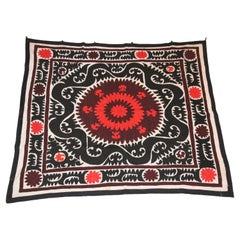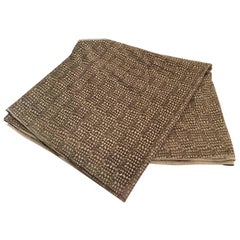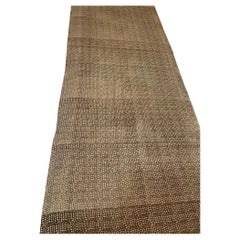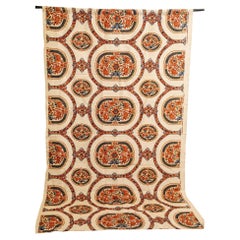Video Loading
Want more images or videos?
Request additional images or videos from the seller
1 of 18
Batik Cotton Print Fabric Brown Black & White Textile Panel Java, 1960s
Price:$150
$195List Price
About the Item
- Dimensions:Height: 40 in (101.6 cm)Width: 75.5 in (191.77 cm)Depth: 0.025 in (0.64 mm)
- Style:Baltic (In the Style Of)
- Materials and Techniques:
- Place of Origin:
- Period:
- Date of Manufacture:1960
- Condition:Wear consistent with age and use. Minor losses. Minor structural damages. one small cut see pictures.
- Seller Location:Moreno Valley, CA
- Reference Number:Seller: BTK7211stDibs: LU906824450252
About the Seller
5.0
Platinum Seller
Premium sellers with a 4.7+ rating and 24-hour response times
1stDibs seller since 2011
3,129 sales on 1stDibs
Typical response time: 1 hour
Authenticity Guarantee
In the unlikely event there’s an issue with an item’s authenticity, contact us within 1 year for a full refund. DetailsMoney-Back Guarantee
If your item is not as described, is damaged in transit, or does not arrive, contact us within 7 days for a full refund. Details24-Hour Cancellation
You have a 24-hour grace period in which to reconsider your purchase, with no questions asked.Vetted Professional Sellers
Our world-class sellers must adhere to strict standards for service and quality, maintaining the integrity of our listings.Price-Match Guarantee
If you find that a seller listed the same item for a lower price elsewhere, we’ll match it.Trusted Global Delivery
Our best-in-class carrier network provides specialized shipping options worldwide, including custom delivery.You May Also Like
Indian Phulkari Wedding Textile, Silk & Cotton Embroidery, Punjab 1900s
Located in Jimbaran, Bali
This strikingly coloured Phulkari is from Punjab, India. It was hand-crafted from silk and cotton, with silk being used for the embroidery. Phulkari’s are a form of wedding shawl and...
Category
Early 20th Century Indian Other Textiles
Materials
Cotton, Silk
$1,745
Free Shipping
H 51.97 in W 88.19 in D 0.02 in
Indian Phulkari Wedding Textile, Silk & Cotton Embroidery, Punjab, 1900s
Located in Jimbaran, Bali
This strikingly coloured Phulkari is from Punjab, India. It was hand-crafted from silk and cotton, with silk being used for the embroidery. Phulkari’s are a form of wedding shawl and...
Category
Early 20th Century Indian Other Textiles
Materials
Cotton, Silk
$1,645
Free Shipping
H 49.22 in W 94.49 in D 0.02 in
Indian Phulkari Wedding Textile, Silk & Cotton Embroidery, Punjab 1900s
Located in Jimbaran, Bali
This strikingly coloured Phulkari is from Punjab, India. It was hand-crafted from silk and cotton, with silk being used for the embroidery. Phulkari’s are a form of wedding shawl and...
Category
Early 20th Century Indian Other Textiles
Materials
Cotton, Silk
$1,945
Free Shipping
H 50.79 in W 88.19 in D 0.02 in
Hand-Drawn Batik Textile, from Java Indonesia
Located in Jimbaran, Bali
A fine example of a batik textile from Solo, Java, Indonesia. This textile features wonderful detailing & contrast. It features a wonderful array of flor...
Category
Early 2000s Indonesian Other Textiles
Materials
Cotton
Hand-Drawn Batik Textile, from Java Indonesia
Located in Jimbaran, Bali
A fine example of a batik textile from Solo, Java, Indonesia. This textile features wonderful detailing & contrast. It features a wonderful array of flor...
Category
Early 2000s Indonesian Other Textiles
Materials
Cotton
Hand-Drawn Batik Textile, from Java Indonesia
Located in Jimbaran, Bali
A fine example of a batik textile from Solo, Java, Indonesia. This textile features wonderful detailing & contrast. It features a wonderful array of flor...
Category
Early 2000s Indonesian Other Textiles
Materials
Cotton
Vintage Hand Dyed Cotton Batik Slendang (Selendang), Java
Located in Point Richmond, CA
Vintage Hand Dyed Cotton Batik Slendang (Selendang), Java. A length of cotton fabric used as a shoulder cloth, hand dyed in two colors: red and blue painted over a wax resist design,...
Category
20th Century Indonesian Other Textiles
Materials
Cotton
Ikat Textile from Timor Island, Indonesia
Located in Jimbaran, Bali
This Ikat textile originates from the Island of Timor, Indonesia. It is hand-woven using naturally dyed yarns via a method passed on through generations. It features a predominantly ...
Category
Mid-20th Century Indonesian Other Textiles
Materials
Yarn
Ikat Textile from Flores Island, Indonesia
Located in Jimbaran, Bali
This Ikat textile originates from the Island of Flores, Indonesia. It is hand-woven using naturally dyed yarns via a method passed on through generations. This textile is tubular for...
Category
Mid-20th Century Indonesian Other Textiles
Materials
Yarn
Ikat Textile from Flores Island, Indonesia
Located in Jimbaran, Bali
This Ikat textile originates from the Island of Flores, Indonesia. It is hand-woven using naturally dyed yarns via a method passed on through generations....
Category
Vintage 1950s Indonesian Other Textiles
Materials
Yarn
More From This Seller
View AllVintage Samarkand Suzani, Uzbekistan Embroidered Textile Red and Black
Located in Moreno Valley, CA
Vintage Samarkand Suzani, Uzbekistan embroidered textile red and black
Tashkent Suzani from Samarkand Uzbekistan, 1950.
Overall good condition for its age and use some stains.
"Suzani" means needlework and these embroideries are some of the most characteristic forms of textile art from Central Asia. The mastery of color and the dynamic sense of movement they convey continue to add depth and joy to contemporary interiors. A high level of creative variation and the individuation of each flower are what make each piece unique.
Measures: 67.5" x 57".
The Silk Road Bukhara: Like scattered pearls along the vast expanse of the Great Silk Road, the cities of Uzbekistan glisten radiantly under the unforgiving sun. This nation, nestled in a picturesque oasis, holds a treasure trove of historical artifacts, owing to its advantageous position at the heart of the ancient Silk Road network. In the year 138 BC, a transformative era commenced as China graciously opened its borders to trade, giving rise to caravans that embarked upon this illustrious route. These trading pathways served as conduits not only for the exchange of goods and craftsmanship but also for the intermingling of cultures, beliefs, and wisdom. Even today, within the ancient walls of cities like Samarkand, one can still discern the echoes of bustling voices, the melodious jingle of camel harnesses...
Category
Early 20th Century Turkish Folk Art Textiles
Materials
Fabric
Woven African Tribal Bogalan Mud Cloth Textile
Located in Moreno Valley, CA
Handwoven Bogolan mud cloth textile from Mali, Africa, Bambara.
It is a handwoven tribal cotton fabric traditionally dyed with fermented mud.
Woven Afr...
Category
20th Century Malian Folk Art Tribal Art
Materials
Cotton
African Batik Cloth Natural Hand-woven Hand-Printed Cotton Fabric Ghana 10 Yards
Located in Moreno Valley, CA
African Batik Cloth Natural Hand-woven Hand-Printed Cotton Fabric Ghana 10 yards.
Colors are organic earth tone beige and light brown in geometric design.
Non waxed fabric circa 1950s.
Hand made in Ghana Africa.
Museum Quality Original Long Piece.
380 inches, (30 ft 10 yards Long) x 46 inches Inches Wide( 4ft).
Could be use to make pillows or upholstery.
History of Batik in Africa:
Batik, a traditional fabric art technique, has a rich history in Ghana, West Africa. The practice of batik involves using wax to create intricate patterns on fabric, which is then dyed to achieve the desired design. While batik has its origins in Asia, particularly in Indonesia, it has been embraced and adapted by various African countries, including Ghana.
In Ghana, batik-making can be traced back to the mid-20th century when it gained popularity as a form of traditional textile art. The craft was introduced by artists and artisans who were inspired by the vibrant and expressive nature of batik. These early practitioners experimented with different designs, colors, and patterns, infusing local themes and motifs into their creations.
Over time, batik became an important part of Ghanaian culture and identity. It is not only used for clothing but also for various decorative and functional items such as wall hangings, tablecloths, and accessories. The art form often reflects the rich cultural heritage of Ghana, incorporating symbols, proverbs, and traditional stories into the designs.
Ghanaian batik artists often employ a combination of traditional and contemporary elements, creating a unique fusion of styles. The process of making batik involves applying hot wax to the fabric using various tools to create the desired patterns. The wax acts as a resist, preventing dye from penetrating the waxed areas. After dyeing, the wax is removed, revealing the intricate designs on the fabric.
Today, batik-making in Ghana continues to thrive as both a traditional craft and a form of artistic expression. Many artisans and designers draw inspiration from Ghana's diverse cultural landscape, incorporating elements from different regions and ethnic groups into their batik creations. The art form has also gained international recognition, with Ghanaian batik products being sought after both locally and abroad.
In summary, the history of batik in Ghana is a testament to the creativity and adaptability of artists who have embraced and transformed this traditional technique into a vibrant and culturally significant art form within the country.
HISTORY OF BATIK
In the mid-nineteenth century, the Belanda Hitam, or "Black Dutchmen," are said to have introduced batik to West Africa after serving as indentured soldiers for the Dutch in Indonesia. Returning from their conscriptions with trunks of fine Javanese batik, the opulent patterns captured the imagination of their friends and relatives. However, textile history is complex, and only a handful of recruits returned to West Africa with batik due to delayed payments.
Batik, with roots traced to Egyptian mummies, is a tradition found globally, from Southeast Asia to Japan and India. Europeans, particularly the Dutch, played a significant role in industrializing batik from the seventeenth century onward.
In West Africa, Dutch Scholar Ineke van Kessel suggests that batik arrived from India over trans-Saharan routes. Local populations, like the Yoruba in Nigeria, incorporated wax printing into their textiles. European traders brought wax and non-wax fabrics to West Africa in the seventeenth century, targeting a population ready for their consumption. European designers adapted prints for the African market...
Category
Mid-20th Century Ghanaian Folk Art Textiles
Materials
Cotton
Franciscan Fabrics San Francisco Hand Block Print Textile Fabric 1970s
Located in Moreno Valley, CA
Franciscan Fabrics Linen Collectable 1970-1979 Time Period Manufactured Interiors Fabric.
Franciscan Fabrics San Francisco hand block print upholstery fabric.
Such a beautiful rich &...
Category
Late 20th Century American Mid-Century Modern Textiles
Materials
Textile
Moorish Paisley Woodblock Printed Textile Wall Hanging
Located in Moreno Valley, CA
Antique Moorish Paisley Kalamkari textile from India.
Hand blocked vegetable and iron oxide dyes on cotton.
The cotton fabric is hand printed using patterned wooden stamps...
Category
Early 20th Century Indian Moorish Textiles
Materials
Fabric
Isfahan Ghalamkar Persian Paisley Textile Block Printed 1950s
Located in Moreno Valley, CA
Vintage large square Isfahan block printed cotton hand printed fabric bedspread or wall Hanging Textile or table cloth.
Isfahan Ghalamkar Persian Paisley Kalamkari textile hand block...
Category
Mid-20th Century Unknown Islamic Textiles
Materials
Fabric



